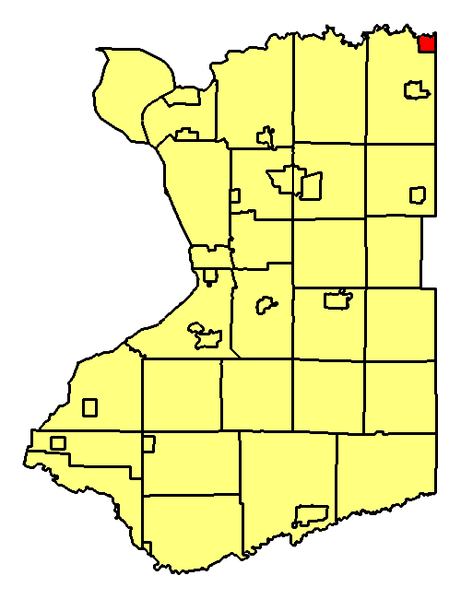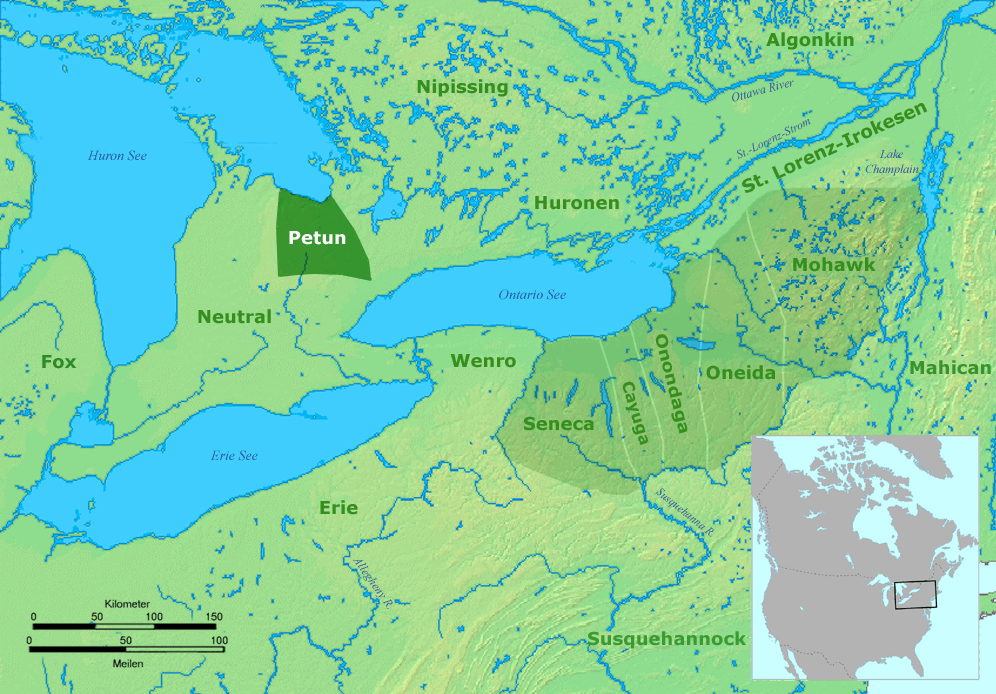|
Oil Springs Reservation
Oil Springs Reservation or Oil Spring Reservation is an Indian reservation of the federally recognized Seneca Nation that is located in southwestern New York, United States. As of the 2010 census, the Indian reservation had one resident; in 2005 no tribal members had lived on the property. The reservation covers about , divided between the present-day counties of Allegany and Cattaraugus. The reservation is northwest of the village of Cuba. It is bordered by the Town of Cuba and the Town of Ischua. The Seneca and earlier indigenous peoples had learned to use the petroleum-tainted water of the spring at this site for medicinal purposes. French Jesuit missionaries learned about its properties from the Seneca and recorded the spring as early as the 17th century. Today the Seneca operate two tax-free gas stations on this reservation to generate revenue for their people's welfare. History When the French Jesuit missionary Joseph de La Roche Daillon reached this area in 1627, the O ... [...More Info...] [...Related Items...] OR: [Wikipedia] [Google] [Baidu] |
Wenrohronon
The Wenrohronon or Wenro people were an Iroquoian indigenous nation of North America, originally residing in present-day western New York (and possibly fringe portions of northern & northwestern Pennsylvania), who were conquered by the Confederation of the Five Nations of the Iroquois in two decisive wars between 1638–1639 and 1643. This was likely part of the Iroquois Confederacy campaign against the Neutral people, another Iroquoian-speaking tribe, which lived across the Niagara River. This warfare was part of what was known as the Beaver Wars, as the Iroquois worked to dominate the lucrative fur trade. They used winter attacks, which were not usual among Native Americans, and their campaigns resulted in attrition of both the larger Iroquoian confederacies, as they had against the numerous Huron. After defeating the Huron in 1649, the Iroquois conducted a December 1649 attack against the Tabacco people, who fell in 1650–1651. The Iroquois continued to campai ... [...More Info...] [...Related Items...] OR: [Wikipedia] [Google] [Baidu] |
Mary Jemison
Mary Jemison (''Deh-he-wä-nis'') (1743 – September 19, 1833) was a Scots-Irish colonial frontierswoman in Pennsylvania and New York, who became known as the "White Woman of the Genesee." As a young girl, she was captured and adopted into a Seneca family, assimilating to their culture, marrying two Native American men in succession, and having children with them. In 1824, she published a memoir of her life, a form of captivity narrative. During the French and Indian War, in spring 1755, Jemison at age 12 was captured with most of her family in a Shawnee raid in what is now Adams County, Pennsylvania. The others of her family were killed. She and an unrelated young boy were adopted by Seneca families. She became fully assimilated, marrying a Delaware (Lenape), and, after his death, a Seneca man. She chose to remain a Seneca rather than return to American colonial culture. Jemison told her story late in life to an American minister, who wrote it for her. He published it as ' ... [...More Info...] [...Related Items...] OR: [Wikipedia] [Google] [Baidu] |
Cornplanter Tract
The Cornplanter Tract or Cornplanter Indian Reservation is a plot of land in Warren County, Pennsylvania that was administered by the Seneca tribe. The tract consisted of along the Allegheny River. The tract comprised the only native reserved lands within the state of Pennsylvania during its existence. It was originally established in 1796 as a grant to Seneca diplomat Cornplanter, also known as John Abeel III, for his personal use, with the right to pass the plot down through his descendants forever. Cornplanter promptly opened up his plot to native settlement, and within two years, 400 Seneca were living on the tract. Internally, the Seneca Nation called the tract the Burned Building, or "Jonöhsade:gëh" in the Seneca language. The tract was never connected to the electric power grid, and buildings there had to rely upon kerosene, coal and oil, which had to be used in furnaces specially built several feet above ground level, since even before the dam was built, the tract was ... [...More Info...] [...Related Items...] OR: [Wikipedia] [Google] [Baidu] |
Cornplanter
John Abeel III (–February 18, 1836) known as Gaiänt'wakê (''Gyantwachia'' – "the planter") or Kaiiontwa'kon (''Kaintwakon'' – "By What One Plants") in the Seneca language and thus generally known as Cornplanter, was a Dutch- Seneca chief warrior and diplomat of the Seneca people. As a war chief, Cornplanter fought in the American Revolutionary War on the side of the British. After the war Cornplanter led negotiations with the United States and was a signatory of the Treaty of Fort Stanwix (1784), the Treaty of Canandaigua (1794), and other treaties. He helped ensure Seneca neutrality during the Northwest Indian War. In the postwar years, Cornplanter endeavoured to learn more about Euro-American culture and invited Quakers to establish schools in Seneca territory. After the War of 1812 he became disillusioned by his people's poor reaction to Euro-American society. He had the schools closed and embraced his half-brother Handsome Lake's movement to return to tradition ... [...More Info...] [...Related Items...] OR: [Wikipedia] [Google] [Baidu] |
Tonawanda Indian Reservation
The Tonawanda Indian Reservation () is an Indian reservation of the Tonawanda Seneca Nation located in western New York, United States. The band is a federally recognized tribe and, in the 2010 census, had 693 people living on the reservation. The reservation lies mostly in Genesee County, extending into Erie and Niagara counties. It is bordered by the Towns of Alabama, Pembroke, Newstead, and Royalton. The Tonawanda Reservation is also known as the Tonawanda Creek Reservation. Currently, it has more than a half dozen businesses located on Bloomingdale Road within the reservation. Several sell untaxed, low-price cigarettes and gasoline. Other businesses sell Seneca craft goods, groceries, and prepared food. History After various cultures of indigenous peoples succeeded each other in the Great Lakes area, in late prehistoric times, the five nations of the Iroquois coalesced. Before the mid-14th century, they had formed the Iroquois Confederacy. The Seneca were one of the F ... [...More Info...] [...Related Items...] OR: [Wikipedia] [Google] [Baidu] |
Buffalo River (New York)
The Buffalo River drains a watershed in Western New York state, emptying into the eastern end of Lake Erie at the City of Buffalo. The river has three tributaries: Cayuga Creek, Buffalo Creek, and Cazenovia Creek. The Buffalo River has been important to the development of western New York, including as the terminus for the Erie Canal beginning in 1825, and later as an industrial area with uses including grain elevators, steel mills and chemical production. When shipping began to bypass the Erie Canal in the 1950s, and later heavy industry declined, the transportation and industrial uses of the river were greatly reduced. Many adjacent factories and grain mills were abandoned. The river and adjacent sites have been the focus of efforts over several decades to improve water quality and restore habitat, most recently in 2011 with the commencement of the Buffalo River Restoration Project. Geography The Buffalo River flows eastward from the point of confluence, passing through resi ... [...More Info...] [...Related Items...] OR: [Wikipedia] [Google] [Baidu] |
Neutral Nation
The Neutral Confederacy (also Neutral Nation, Neutral people, or ) was a tribal confederation of Iroquoian peoples. Its heartland was in the floodplain of the Grand River in what is now Ontario, Canada. At its height, its wider territory extended toward the shores of lakes Erie, Huron, and Ontario, as well as the Niagara River in the east. To the northeast were the neighbouring territories of Huronia and the Petun Country, which were inhabited by other Iroquoian confederacies from which the term Neutrals was derived. The five-nation Iroquois Confederacy was across Lake Ontario to the southeast. Like others of Iroquoian language and culture, the tribes would raid and feud with fellow Iroquoian tribes. They were generally wary of rival Algonquian-speaking peoples, such as those who inhabited Canada to the East, along the St. Lawrence Valley basin. Iroquoian tribes were later known to historians for the fierce ways in which they waged war. A largely agrarian society, the ... [...More Info...] [...Related Items...] OR: [Wikipedia] [Google] [Baidu] |
Cattaraugus Creek
Cattaraugus Creek is a stream, approximately long, in western New York in the United States.Gravel mining; Summary of permits for mining activities in the Cattaraugus Creek watershed ''Cattaraugus Creek watershed resource guide and proposed watershed planning strategy'', 2006, Boyer, B., Carpenter, B., Renschler, C., & Kellam, R.V., Funded by: U.S. Environmental Protection Agency Great Lakes National Program Office, U.S. Army Corps of Engineers Buffalo District, Retrieved 21 June 2014.Kirby, C.D. (1976). ''The Early History of Gowanda and The Beautiful Land of the Cattaraugus''. Gowanda, NY: Niagara Frontier Publishing Company, Inc./Gowanda Area Bi-Centennial Committee, Inc.''Historical sk ... [...More Info...] [...Related Items...] OR: [Wikipedia] [Google] [Baidu] |
Allegheny River
The Allegheny River ( ; ; ) is a tributary of the Ohio River that is located in western Pennsylvania and New York (state), New York in the United States. It runs from its headwaters just below the middle of Pennsylvania's northern border, northwesterly into New York, then in a zigzag southwesterly across the border and through Western Pennsylvania to join the Monongahela River at the Forks of the Ohio at Point State Park in Downtown Pittsburgh, Pennsylvania. The Allegheny River is, by volume, the main headstream of both the Ohio and Mississippi Rivers. Historically, the Allegheny was considered to be the upper Ohio River by both Native Americans and European settlers. This shallow river has been made navigable upstream from Pittsburgh to East Brady, Pennsylvania, East Brady by a series of locks and dams that were constructed during the early 20th century. A 24-mile-long portion of the upper river in Warren County, Pennsylvania, Warren and McKean County, Pennsylvania, McKean c ... [...More Info...] [...Related Items...] OR: [Wikipedia] [Google] [Baidu] |
Treaty Of Canandaigua
The Treaty of Canandaigua (or Konondaigua, as spelled in the treaty itself), also known as the Pickering Treaty and the Calico Treaty, is a treaty signed after the American Revolutionary War between the Grand Council of the Six Nations and President George Washington, representing the United States of America. It was signed at Canandaigua, New York, on November 11, 1794, by fifty sachems () and war chiefs representing the Grand Council of the Six Nations of the Haudenosaunee (Iroquois) Confederacy (including the Cayuga, Mohawk, Oneida, Onondaga, Seneca and Tuscarora Nations) and by Timothy Pickering, official agent of President Washington. Background of the treaty The Treaty of Canandaigua arose out of a combination of geo-political tensions. In the aftermath of its defeat in the American Revolutionary War, Great Britain was forced to relinquish its land east of the Mississippi River to the United States. However, Great Britain’s original rights to this territory were ... [...More Info...] [...Related Items...] OR: [Wikipedia] [Google] [Baidu] |
Fur Trade
The fur trade is a worldwide industry dealing in the acquisition and sale of animal fur. Since the establishment of a world fur market in the early modern period, furs of boreal ecosystem, boreal, polar and cold temperate mammalian animals have been the most valued. Historically the trade stimulated the exploration and colonization of Siberia, northern North America, and the South Shetland Islands, South Shetland and South Sandwich Islands. Today the importance of the fur trade has diminished; it is based on pelts produced at fur farms and regulated fur-bearer trapping, but has become controversial. Animal rights organizations oppose the fur trade, citing that animals are brutally killed and sometimes skinned alive. Fur has been replaced in some clothing by synthetic fiber, synthetic imitations, for example, as in ruffs on hoods of parkas. Continental fur trade Russian fur trade Before the European colonization of the Americas, Russia was a major supplier of fur pelts to W ... [...More Info...] [...Related Items...] OR: [Wikipedia] [Google] [Baidu] |




